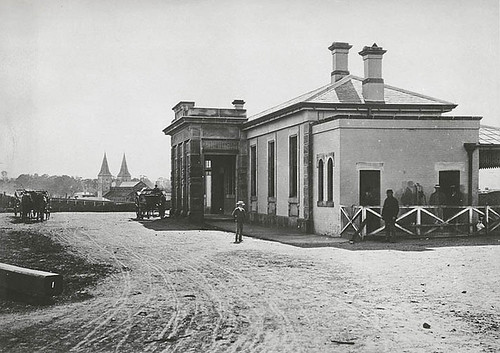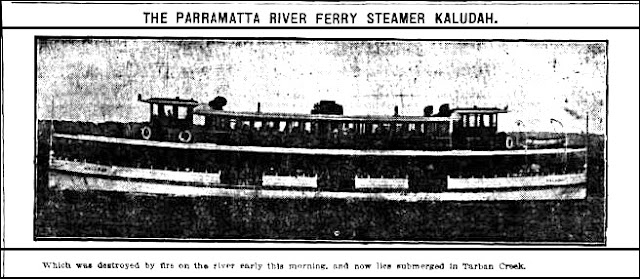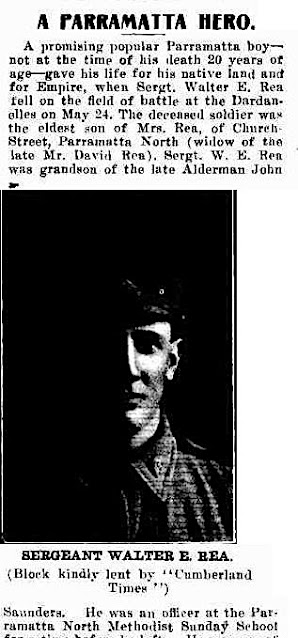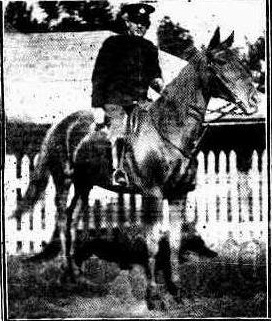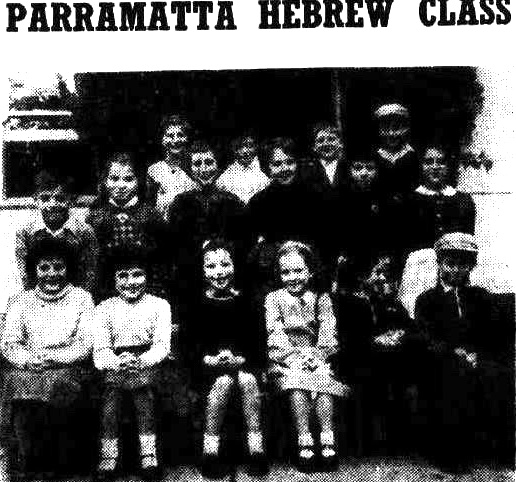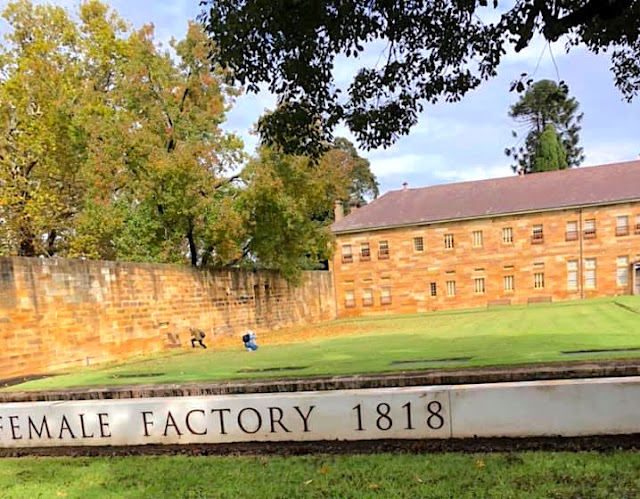Parramatta, which was initially called Rose Hill by the British, is located in New South Wales, Australia, 24 km from Sydney CBD.
As a town, Parramatta is almost as old as Sydney, as it was established in the same year of 1788.
The Darug Aboriginal People (Burramatta Clan)
The name "Parramatta" is of Aboriginal origin, meaning "head of waters", "the place where the eels lie down". The Darug Aboriginal people have lived around the Parramatta region for around 30,000 years, engaging in fish-trapping and controlled burning to encourage plant growth and facilitate hunting.
Evidence of Darug Burramatta culture can be seen in the scarred trees, which were used to make canoes, and the shells, taken from middens, used in the mortar of Old Government House during its construction. On the southern shore of Lake Parramatta, native plants used by the Burramatta people can be found.
Sir William Dawes, an officer of the First Fleet, was the first person to record the original Aboriginal languages of the Darug people. Some Darug words absorbed into English are: dingo, koala, wallaby and wombat.
Aboriginal totems are a natural object, plant, animal and even weather, that is inherited by members of a Clan. Darug totems include the Goanna, Lizards, Cockatoos, Eagle, Grasshoppers, Butterflies, Spiders and their Web, Bees, Honey Combs and even Ants.
Most Australian Aboriginal Clans, as Animists, hold the belief that objects, places, and creatures all possess a distinct spiritual essence. Songlines, which are paths across the land (or sky), mark the route of "creator-beings" during the Dreamtime.
People who share the same totem have a special relationship with each other but cannot marry.
Genetic analysis of the Y chromosome shows that Aboriginal Australians may have 50,000 years of history separated from the rest of humankind. Other evidence, however shows that people from India arrived around 4,000 to 5,000 years ago, a period when there were significant changes in languages and stone tools. Dingos also arrived at this time.
Around the age of 14 male Darug youths would be initiated. Bora ceremonies could be conducted and the youths would be covered in ochre and grease and given a possum belt to wear. Charcoal was added to the head, which was draped in a cloak of skin. After being given a totem name, the youth was prohibited from eating that animal. As part of the initiation the front tooth was knocked out.
Only men could take part or view these initiation ceremonies. Women were forbidden to attend. Women conducted separate ceremonies, from which males were prohibited.
The Battle of Parramatta
The Darug Aboriginal peoples were the first clans to experience the arrival of the British in 1788.
The saying may be a cliché, but “One man's terrorist is another man's freedom fighter” is often true. Pemulwuy was an Aboriginal Australian man born around 1750. His people were the original inhabitants of the region of Toongabbie and Parramatta.
Pemlwuy would have been distinctive to look at, as it is said that he had a turned eyeball and a mutilated foot. The foot damage was an action of the Kurdaitcha (tribal sorcerers), probably to mark Pemlwuy as a carradhy ("clever man" or healer).
Pemlwuy would have been distinctive to look at, as it is said that he had a turned eyeball and a mutilated foot. The foot damage was an action of the Kurdaitcha (tribal sorcerers), probably to mark Pemlwuy as a carradhy ("clever man" or healer).
Pemlwuy certainly became a noted person who inspired fear, horror and reverence, as he became a leader of Aboriginal resistance against the British. He was deemed an outlaw by Governor King I May 1801.
The Battle of Parramatta involved Pemulwuy leading the revolt, with about 100 Aboriginal people, on a government farm at Toongabbie, where British soldiers maintained a garrison.
.jpg) |
| A scarred tree, probably used to make a coolamon (carrying vessel). (Parramatta, NSW). Author: Jens-Uwe Korff |
The Bidjigal fighters threw many spears and Pemulwuy speared one of the soldiers and in response, the troops shot him seven times. As an act of compassion, the soldiers took the wounded Pemulwuy to the hospital at Parramatta, but he later escaped and continued his campaign of resistance.
It was on the 22nd of April 1788 that Governor Arthur Philip led an expedition into the west of Sydney. The party travelled by boat in search of arable land suitable for producing food for the fledgeling and hungry colony.
With British arrival, the Aboriginal people were hit hard by diseases such as small-pox, which had emerged in humans sometime after the first agricultural settlements farmed animals about 10,000 BCE. Aboriginal people had no immunity to these diseases, and populations were decimated.
Governor Philip was pleased with the soil quality and water resources around Parramatta and preferred it as a settlement site to the one already established on Sydney Harbour. However, it wasn't until November 2 that farm settlements were chosen at Parramatta by a group of convicts and soldiers, who established farms to the east of where Old Government House is today.
The Ex-convict, James Ruse, was the first person in NSW to receive a land grant after successfully growing the first wheat in the colony.
The convicts- were employed in clearing land near to "The Camp," and rendering it fit for growing grain, vegetables, fruit, etc. Those prisoners were difficult to manage and keep in subjection. Many absconded to the bush. At one period a number of convicts who had been sent from Ireland broke into open rebellion, and loudly avowed their determination to free themselves by destroying the whole free people and constituted authorities. Their revolt was a signal failure. Many were shot down, and others executed, by a force organised by Colonel Johnston, of the Marines.
After this, the town began to extend and improve. Streets were formed, residences erected, and every encouragement given by the Government for people to settle in the town and suburbs. A wooden bridge was put up to cross the river, both sides of which were known by the words, "Over the Water." The wooden bridge was washed away by a heavy flood, and the present substantial stone structure, "Lennox Bridge," erected, which has ever since, stood its ground. Parramatta, from its salubrity, its quiet, its comfortable hotels, etc., was always an attractive and enjoyable place, one to which the Sydney, Windsor, Liverpool and other people would now and then, on special festive occasions — viz., Parramatta Fair, The Blackfellows’ Feast, and other sports— assemble, and have a most enjoyable time for nearly a week.
Agricultural Society established in 1822.
Henry Harvey, a baker, built a steam-operated mill between 1840 and 1841 and commenced producing flour.
By 1847 the population had increased to 4500.
1850s
Parramatta Amateur Dramatic Society formed in 1870.
 |
| Aboriginal man with spear, Michael Coghlan |
1788: The British
It was on the 22nd of April 1788 that Governor Arthur Philip led an expedition into the west of Sydney. The party travelled by boat in search of arable land suitable for producing food for the fledgeling and hungry colony.
With British arrival, the Aboriginal people were hit hard by diseases such as small-pox, which had emerged in humans sometime after the first agricultural settlements farmed animals about 10,000 BCE. Aboriginal people had no immunity to these diseases, and populations were decimated.
Governor Philip was pleased with the soil quality and water resources around Parramatta and preferred it as a settlement site to the one already established on Sydney Harbour. However, it wasn't until November 2 that farm settlements were chosen at Parramatta by a group of convicts and soldiers, who established farms to the east of where Old Government House is today.
After the convicts cleared the land, Governor Philip named the area Rose Hill. The success of these farms was critical to the survival and development of the colony.
King’s Wharf, Parramatta, established in 1788.
King’s Wharf, Parramatta, established in 1788.
The Lump
Late in 1789, the Rose Hill Packet, the first boat built in the colony, often called "The Lump", due to its barge-like shape, returned from Rose Hill on its maiden voyage, with the area's first harvest. The 200 bushels of wheat, 35 bushels of barley and a small quantity of Indian corn was a positive start for Governor's Farm, especially since rations in the colony were running low.
James Ruse
On 1st November 1789, Governor Phillip granted Ruse 30 acres of land at Parramatta. In 1793, Ruse sold the land to Dr John Harris of the New South Wales Corps for 40 pounds. The property is now the Experiment Farm Cottage. This was Australia's first private farm.
Rose Hill renamed Parramatta in June 1791.By the end of 1791, Parramatta was still a small riverside village consisting of George and Church Streets; however, the settlement was bigger than Sydney. The population of currency lads and lasses was also growing; these were the children of convicts or emancipists, who were growing taller than their parents and had a different way of speaking.
"Captain Watkin Tench, of the
Marines, writing in December, 1791, said of Sydney that it
"had long been considered as only a. depot for stores; it
exhibited nothing but a few old scattered huts and some
sterile gardens; cultivation of the ground (i.e., at Farm
Cove and on Garden Island) was abandoned, and all our
strength transferred to Rose Hill." The place had, how
ever, already received its new name, with its assumption of
dignity as a regularly laid-out town, possessing measured
streets 205 feet wide, Phillip had, on June 4th, 1791, restored
to its native and euphonious name of Parramatta."
Marines, writing in December, 1791, said of Sydney that it
"had long been considered as only a. depot for stores; it
exhibited nothing but a few old scattered huts and some
sterile gardens; cultivation of the ground (i.e., at Farm
Cove and on Garden Island) was abandoned, and all our
strength transferred to Rose Hill." The place had, how
ever, already received its new name, with its assumption of
dignity as a regularly laid-out town, possessing measured
streets 205 feet wide, Phillip had, on June 4th, 1791, restored
to its native and euphonious name of Parramatta."
Sydney Mail and New South Wales Advertiser (NSW : 1871 - 1912), Wednesday 22 November 1911
The first road from Sydney to Parramatta was built in 1793.
 |
| The BL King’s Topographical Collection: "[View of Parramatta from near Rose Hill]." Date of publication: [April 1793] British Library |
Ten Hotels
The Woolpack was one of the first 10 hotels licensed in Australia by Governor Phillip in May 1796.
Originally, the inn, was established as the Freemason Arms by James Larra, a former convict, who some sources cite as being a French forger of Jewish background. The dining room attached to the inn was Australia’s first restaurant. The Woolpack Inn was given its current name in 1821 but moved to its current location to make way for the second courthouse.
A Well-Ordered Town
Parramatta was transformed into a well-ordered town under governor Lachlan Macquarie, who took office in 1809. Macquarie directed the building of the Lancer Barracks, part of old Government House and the two towers of St John's Church. It was also Macquarie who founded the Native Institution in Parramatta for the education of Aboriginal children.
 |
| The Governor's House at Rose Hill (Parramatta) NSW, Sydney Mail (NSW : 1912 - 1938) |
 |
| Government House Parramatta, NSW, circa 1805 |
By 1798 Parramatta had five inns— the Free Masons' Arms (later the Woolpack), Yorkshire Grey, The
Crown, The Ship and The Salutation.
Crown, The Ship and The Salutation.
1800s
Thomas Ruchtons first Parramatta brewery was on the corner of O’Connell and George Streets. Governor King gave Rushton permission for his brewery in 1803.
The first free settlers arrived in the colony in 1793 on the Bellona. These settlers would begin to transform the colony with their innovation and industry. Shops and businesses began to be established; the Sydney Gazette writing in 1834 that "...Parramatta can now boast of some shops which would be worthy of observation and praise were they transferred to George Street, Sydney".
The town was formed very soon, only a few weeks after Sydney, and was intended to be utilized for growing grain — wheat, maize, oats, etc. — for food for the people of the Colony of New South Wales. The first location was at the place in the Park, now known as Old Government House. The Commandant’s house was put up on that spot, and other buildings for the officers and soldiers, with huts and barracks for the convicts, were erected close by. This spot was called, and for years after was known as "The Camp." A road running easterly was formed (now George-street), leading to the landing place of the river (now the site of the Benevolent Asylum), ordered to be one mile long and about 200 feet wide.
The town was formed very soon, only a few weeks after Sydney, and was intended to be utilized for growing grain — wheat, maize, oats, etc. — for food for the people of the Colony of New South Wales. The first location was at the place in the Park, now known as Old Government House. The Commandant’s house was put up on that spot, and other buildings for the officers and soldiers, with huts and barracks for the convicts, were erected close by. This spot was called, and for years after was known as "The Camp." A road running easterly was formed (now George-street), leading to the landing place of the river (now the site of the Benevolent Asylum), ordered to be one mile long and about 200 feet wide.
The convicts- were employed in clearing land near to "The Camp," and rendering it fit for growing grain, vegetables, fruit, etc. Those prisoners were difficult to manage and keep in subjection. Many absconded to the bush. At one period a number of convicts who had been sent from Ireland broke into open rebellion, and loudly avowed their determination to free themselves by destroying the whole free people and constituted authorities. Their revolt was a signal failure. Many were shot down, and others executed, by a force organised by Colonel Johnston, of the Marines.
Excerpt from The Cumberland Argus and Fruitgrowers Advocate, 26 December 1896 Read here
The Colonial Hospital was established in Parramatta in 1818, later becoming the Parramatta District Hospital.
Many people left their mark on the town of Parramatta; such as, the Reverend Samuel Marsden known as the "flogging parson", who came to live in Parramatta in 1794.
The Colonial Hospital was established in Parramatta in 1818, later becoming the Parramatta District Hospital.
The Royal Oak Hotel, which was located at 387 Church Street North Parramatta, is one of Australia's first hotels. It was established about 1813 by John Metcalf (1783-1850), an emancipated convict. John Tunks (Tonks) was the Publican of the hotel from 1832 to 1839, when it was called the Shamrock Rose & Thistle.
This irreplaceable historic hotel was demolished for the Parramatta Light Rail. Tunks also built a large house in Church St Parramatta called Norfolk House. It still stands in Church Street opposite the Catholic Cemetery.
Marsden's Mark
Many people left their mark on the town of Parramatta; such as, the Reverend Samuel Marsden known as the "flogging parson", who came to live in Parramatta in 1794.
In 1796, Marsden began church services in a makeshift building of two old timber huts at the corner of George and Marsden Streets (the site of the present-day Law Courts).
The Reverend was of a puritanical nature and he compiled a list of women in the colony called The Female Register, which categorised women into three categories: "married", "widowed" or "concubine".
The Reverend only recognised marriage in the Anglican Church, so women of other religions, such as Catholic and Jewish women, were immediately placed in the "concubine" category. Reverend Marsden is buried in St. John's graveyard, Parramatta.
These outcast women: the Parramatta Female Factory, 1821-1848, by Annette Salt, is a book which contains much detail about the lives of some of the convict women of the Parramatta Female Factory, and their descendants.
The first public fair held "by regular authority" took place at Parramatta in March 1813.
 |
| Portrait of Samuel Marsden, 1764 - 1838 |
Our Founding Mothers
The women of the Parramatta Female Factory have been painted in stereotyped ways as being women of loose morals and criminals engaged in debauchery. But most of these women were young and single, and many had been domestic servants and/or had come from a semi-skilled background.
Some of these convict women were mothers who worked hard: They were also survivors whose food rations were close to starvation level on many occasions. Women who were deemed well-behaved were chosen to be wives and servants, while the difficult cases were locked up or sent to Newcastle, to the coal works.
The first Female Factory at Parramatta 1802–1821 was located over the old gaol. It was a wool and linen factory, where women worked by day and slept at night.
By 1822, a new three-storey building of stone had been constructed for the female convicts at Parramatta. Governor Macquarie described the new factory as:
A Large Commodious handsome stone built Barrack and Factory, three storeys high, with Wings of one storey each for the accommodation and residence of 300 Female Convicts, with all the requisite Out-offices including Carding, Weaving and Loom Rooms, Work-Shops, Stores for Wool, Flax, etc, etc.; Quarters for the Superintendent, and also a large Kitchen Garden for the use of the Female Convicts, and Bleaching Ground for Bleaching the Cloth and Linen Manufactured; the whole of the Buildings and said Grounds, consisting of about Four acres, being enclosed with a high Stone Wall and Moat or Wet Ditch.
St. John's Church
The original St. John's Church, Parramatta, used by Samuel Marsden, was built between 1799 and 1802. Between 1817 and 1819, a facade incorporating twin towers topped with spires was added, copied from those of St Mary's Church, Reculver, in Kent, England.
The original St. John's Church, Parramatta, used by Samuel Marsden, was built between 1799 and 1802. Between 1817 and 1819, a facade incorporating twin towers topped with spires was added, copied from those of St Mary's Church, Reculver, in Kent, England.
St John's was damaged by a storm on 21 December 1841 and was a "perfect ruin" by 1852. The foundation stone of the new St. John's was laid on 11 August 1852.
 |
| St. John's Church, Parramatta, NSW, used by Samuel Marsden was built between 1799 and 1802. Sydney Mail (NSW : 1912 - 1938), Wednesday 25 October 1933 |
In 1818 Governor Macquarie ordered a dam to be built across the Parramatta River, called the Town Dam.
The hospital at Parramatta in 1818 was known as the Colonial Hospital.
Parramatta Observatory was set up in 1821 by Governor Sir Thomas Brisbane at his own expense. All that now remains on the observatory are Transit Piers and the marble obelisk in Parramatta Park.
 |
| Governor Brisbane's Observatory in Parramatta Park, NSW, Sydney Mail (NSW : 1912 - 1938), Wednesday 25 October 1933 |
The Parramatta bathhouse was built in 1823 for Governor Brisbane. Water was pumped through lead pipes from the river, and used water was run off through brick drains into a nearby duck pond. The Bath House was made into a pavilion in 1886.
 |
| The Parramatta bathhouse was built in 1823 for Governor Brisbane, NSW, Sydney Mail (NSW : 1912 - 1938), Wednesday 26 October 1938 |
Brislington House built in 1821, the oldest inner-city house in Parramatta, is now a medical and nursing museum. The building was constructed in 1821 for ex-convict John Hodges as a condition of his application to Governor Macquarie for a Liquor License, using money he won in a card game at the Woolpack Inn.
 |
| Brislington House built in 1821 the oldest inner city house in Parramatta, NSW, now a medical and nursing museum, Daily Telegraph (Sydney, NSW : 1931 - 1954), Thursday 20 October 1938 |
Howells' Mill was a combined wind and water mill built in 1828 on the southern bank of the Parramatta River by ex-convict George Howell and his son George.
1830s
The King's School located in North Parramatta was founded in 1831.
The first steam ferry to operate between Sydney and Parramatta was named "Surprise," beginning service on 2 June 1831. The original wharf was built by convicts from gum tree logs then reconstructed with sandstone in 1835.
The Parramatta Advertiser newspaper was launched 15th June 1833.
Lennox Bridge Parramatta completed in 1839.
Charles Darwin
During Charles Darwin's 5 year voyage around the world, in the "Beagle", he spent 19 days docked in Sydney in 1836. Darwin then “hired a man & two horses to take [him] to Bathurst…to get a general idea of the country”.
During Charles Darwin's 5 year voyage around the world, in the "Beagle", he spent 19 days docked in Sydney in 1836. Darwin then “hired a man & two horses to take [him] to Bathurst…to get a general idea of the country”.
"In the morning of the 16th I set out on my excursion [to Bathurst]; the first stage took us through Paramatta, a small country town, but second to Sydney in importance . . . The road appeared much frequented by all sorts of carriages. — I met two Stage Coaches. — In all these respects there was a most close resemblance to England; perhaps the number of Ale-houses was here in excess".
“Accompanied by Capt. King rode to Paramatta. Close to the town, his brother in law Mr MacArthur lives & we went there to lunch. The house would be considered a very superior one, even in England. — There was a large party, I think about 18 in the Dining room. — It sounded strange in my ears to hear very nice looking young ladies exclaim, ‘Oh we are Australian, & know nothing about England’. — In the afternoon I left this most English-like house & rode by myself into Sydney”.
“Accompanied by Capt. King rode to Paramatta. Close to the town, his brother in law Mr MacArthur lives & we went there to lunch. The house would be considered a very superior one, even in England. — There was a large party, I think about 18 in the Dining room. — It sounded strange in my ears to hear very nice looking young ladies exclaim, ‘Oh we are Australian, & know nothing about England’. — In the afternoon I left this most English-like house & rode by myself into Sydney”.
1840s
James and William Byrnes in 1841 built a steam flour mill on land leased from the Elizabeth farm estate, they then operated a river ferry service in the 1840s and 50s. By January 1847, the brothers built a five-storey cloth mill manufacturing lama cloth, tweeds (and a durable cloth called "Parramatta Tweed"). The machinery was imported from England and in the beginning, there were 39 employees.
1850s
Endrim, a heritage-listed former residence and clergy house and now offices located at 54 Sorrell Street, Parramatta, was designed by James Houison and built from 1854 to 1856.
On 26 September 1855, the Railway opened to Parramatta Junction near Granville.The masonry arch-walled dam across Hunts Creek was completed in 1856 to supply water for domestic purposes.
In 1858, Parramatta Park was created as a "Park for the People".
The Parramatta Volunteer Fire (PVF) Brigade was formed in 1859.
1860sParramatta Borough Council was incorporated in 1861 with John Williams as first Mayor.
In April 1862, Elder’s House, on the corner of George and Marsden Streets (now the site of the Woolpack Hotel), was rented as Council offices for ten years.
1870s
.
State-Heritage-listed Willow Grove was built in the 1870s as a private villa, once operated as a maternity hospital known as "Estella". The controversial decision to demolish the building to construct a Powerhouse Museum (otherwise known as The Milk-Crate) on flood-prone land. Hopefully saved from demolition. |
| Parramatta Station, NSW, 1870, Blue Mountains Library, Local Studies |
 |
| Parramatta Volunteer Fire Brigade, NSW. c1871. (State Library of NSW) |
 |
| Church St. Parramatta, NSW, 1875, SLVIC |
1880s
The Parramatta Town Hall, designed by Blackburn and Parkes in the Victorian Free Classical style, was completed in 1883 at the cost of £2,300.
 |
| The foundation of the King's School Chapel was laid in 1887 by Lady Carrington, and was finished two years later. Sydney Morning Herald (NSW : 1842 - 1954), Saturday 6 February 1932 |
1890s
 |
| Baldwin steam tram 78 "The last tram from Leichhardt to Parramatta" NSW. "Cowcatcher" attached to front, c. 1890 - unknown photographer |
 |
| Church St, Parramatta - looking north, after 1897. NSW State Archives |
 |
| Church Street, Parramatta, NSW, Sydney Mail and New South Wales Advertiser (NSW : 1871 - 1912), Saturday 10 June 1899 |
1900s
First motor car drives in Parramatta in 1900.
 |
| Parramatta Cordial Factory, NSW, Cumberland Argus and Fruitgrowers Advocate (Parramatta, NSW : 1888 - 1950), Saturday 14 December 1901 |
 |
| W. Baker and Sons' New Bakery, Harris Park, Parramatta, NSW. Cumberland Argus and Fruitgrowers Advocate (Parramatta, NSW : 1888 - 1950), Saturday 14 December 1901 |
 |
| Harvey's Mill, The Cumberland Steam Mill, and Dares Mill, Parramatta , NSW, early 1900s |
 |
| The Parramatta Town Hall, NSW, designed by Blackburn and Parkes in the Victorian Free Classical style, was completed in 1883 at a cost of £2,300. c1905/10 |
 |
| Parramatta District Hospital, NSW, Cumberland Argus and Fruitgrowers Advocate (Parramatta, NSW : 1888 - 1950), Wednesday 18 December 1907 |
 |
| Some of the committee and staff of the Parramatta District Hospital, NSW, Cumberland Argus and Fruitgrowers Advocate (Parramatta, NSW : 1888 - 1950), Wednesday 18 December 1907, |
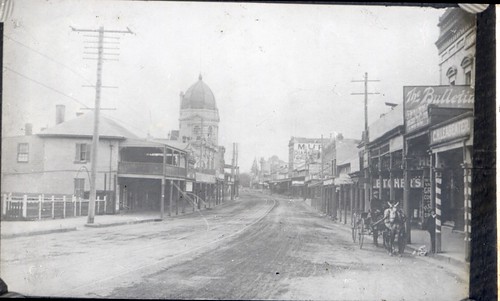 |
| Church Street, Parramatta, NSW, n.d. Royal Australian Historical Society |
 |
| Parramatta Woollen Mill, NSW, Australian Town and Country Journal (Sydney, NSW : 1870 - 1919), Wednesday 15 November 1905 |
 |
| Welcome at the Parramatta Town Hall, Sydney for the US Fleet - 1908. |
 |
| A POPULAR PARRAMATTAESTABLISHMENT. NSW. Sun (Sydney, NSW : 1910 - 1954), Thursday 30 October 1913 |
WWI
 |
| Cumberland Argus and Fruitgrowers Advocate (Parramatta, NSW : 1888 - 1950), Saturday 27 February 1915 |
 |
| Parrmatta North Football Club were Western District Junior League A Grade Premiers,Cumberland Argus and Fruitgrowers Advocate (Parramatta, NSW : 1888 - 1950), Saturday 2 September 1916 |
1920s
"During the course of an interview
with Mr, G. S. Hill, of Bungay, near
Wingham, the following interesting
narrative was given with regard to
Billy Johnston, an early day Manning
blackfellow, whose photograph is
also reproduced here.
Mr. Hill said: Billy Johnston told
me he was born at Curricabakh, and
when he was about nine or ten years
of age he was put upon a horse at
Giro, and taken by Gilbert Elliott, a
squatter of New England at the time,
to Parramatta. At Parramatta Billy
was sent to a school for a year or
two.
Billy's account of the trip to me
that he cried all the way from Giro
to Raymond Terrace, said Mr. Hill.
Upon returning to his native district,
he joined his tribe again."
with Mr, G. S. Hill, of Bungay, near
Wingham, the following interesting
narrative was given with regard to
Billy Johnston, an early day Manning
blackfellow, whose photograph is
also reproduced here.
Mr. Hill said: Billy Johnston told
me he was born at Curricabakh, and
when he was about nine or ten years
of age he was put upon a horse at
Giro, and taken by Gilbert Elliott, a
squatter of New England at the time,
to Parramatta. At Parramatta Billy
was sent to a school for a year or
two.
Billy's account of the trip to me
that he cried all the way from Giro
to Raymond Terrace, said Mr. Hill.
Upon returning to his native district,
he joined his tribe again."
 |
| Governor General at Elizabeth farm, Parramatta, NSW, Sydney Mail (NSW : 1912 - 1938), Wednesday 31 March 1926 |
 |
| Parramatta High School teachers, NSW, Cumberland Argus and Fruitgrowers Advocate (Parramatta, NSW : 1888 - 1950), Thursday 19 September 1929 |
1930s
 |
| The New Parramatta Markerts, NSW, Cumberland Argus and Fruitgrowers Advocate (Parramatta, NSW : 1888 - 1950), Thursday 31 December 1931 |
 |
| Town Hall, Parramatta. NSW, n.d. NSW State Archives |
 |
| Cumberland Argus and Fruitgrowers Advocate (Parramatta, NSW : 1888 - 1950), Thursday 29 November 1934 |
 |
| Parramatta's Roxy Theatre in 1930, NSW. SLNSW |
 |
| Parramatta first mayor, NSW, Sun (Sydney, NSW : 1910 - 1954), Sunday 30 October 1938 |
 |
| Parramatta celebrations, NSW, c1938, Sam Hood, SLNSW |
 |
| "A new Grace Bros regional store at Parramatta October 1939. By Sam Hood. From the Mitchell Library collection of the State Library of New South Wales |
 |
| Jack Cooper's White Horse Hotel, Church Street, Parramatta, NSW. Cumberland Argus and Fruitgrowers Advocate (Parramatta, NSW : 1888 - 1950), Wednesday 19 May 1948 |
 |
| Jack Cooper's White Horse Hotel, Church Street, Parramatta, NSW. Cumberland Argus and Fruitgrowers Advocate (Parramatta, NSW : 1888 - 1950), Wednesday 19 May 1948 |
 |
| View from St John's Park to Church Street, Parramatta, NSW. Dated: No date. NSW State Archives |
1950s
 |
| Sydney Morning Herald (NSW : 1842 - 1954), Tuesday 13 April 1954 |
1960s
 |
| Church Street 1967. The large star in the skyline shows the location of the Star Hotel. Heritage Centre Cultural Collections ACC002_032 |
What Lies Beneath
Archaeologists have uncovered the cellar of the Wheatsheaf Hotel, believed to have been built in 1801, along with the remains of a convict hut and a wheelwright's workshop, where carts and wagons were once made and fixed.
Archaeologists have uncovered the cellar of the Wheatsheaf Hotel, believed to have been built in 1801, along with the remains of a convict hut and a wheelwright's workshop, where carts and wagons were once made and fixed.
The team also found a well for drinking water, a baker's oven, along with dinner plates, children's toys and bottles. This important part of our heritage lies beneath 600 apartments, a pool, gym, 5-star hotel and restaurants.
Multicultural Parramatta
Multicultural Parramatta
Much has changed since the first contact between the Aboriginal people of Parramatta, and the period of British settlement. Waves of immigration and settlement of refugees have occurred in the last thirty to forty years, and Parramatta is now extremely, culturally diverse. Significant populations of people from India have settled at Parramatta, as well as migrants from China, Sri Lanka, Lebanon, Korea and Iran.
Sadly, Parramatta has lost much of its charm and character with the continued destruction of heritage buildings and the construction of ugly blocks of flats.
A high-rise school for 3000 students is scheduled for 2019, which will further change the character and landscape and the lives of people who live at Parramatta. Though, at least for now, some of Australia's most important heritage places and buildings are still here, and you can find them if you look hard enough.
Parramatta Pioneers
Also lying in St. John's Cemetery is Baron Augustus Theodore Harman Alt von Hesse-Kassel, simply known as Augustus Alt. His father was a German Hessian and his mother a Scotswoman. Alt, who was appointed Surveyor General of the colony, arrived aboard the Prince of Wales, with the First Fleet in 1788. Although Alt assumed the title of Baron in later life, there is no evidence that the German Emperor ever granted him this title.
After arriving in the colony, Alt laid out the settlements of Albion (later Sydney), Parramatta and Tongabby (later Toongabbie). He moved to Parramatta in 1810 and had two children, Lucy and Henry, with Ann George, a convict, who arrived on the Lady Penrhyn. The couple never married.
Also lying in St. John's Cemetery is Baron Augustus Theodore Harman Alt von Hesse-Kassel, simply known as Augustus Alt. His father was a German Hessian and his mother a Scotswoman. Alt, who was appointed Surveyor General of the colony, arrived aboard the Prince of Wales, with the First Fleet in 1788. Although Alt assumed the title of Baron in later life, there is no evidence that the German Emperor ever granted him this title.
After arriving in the colony, Alt laid out the settlements of Albion (later Sydney), Parramatta and Tongabby (later Toongabbie). He moved to Parramatta in 1810 and had two children, Lucy and Henry, with Ann George, a convict, who arrived on the Lady Penrhyn. The couple never married.
Eleanor McCabe
Eleanor McCabe and her husband, Christopher Magee were very early settlers in Parramatta. Eleanor was a “hawker”, who was tried at the Old Bailey for assaulting a man named John Harris on 11 May 1785. Eleanor had been tried before, for other crimes including prostitution, but on this occasion, she and three other women violently attacked the prosecutor and unsurprisingly, she was sentenced to seven years transportation, to the colony of New South Wales.
As a First Fleet convict travelling aboard the Lady Penrhyn in February 1787, Eleanor experienced a still-born birth. Then, during the voyage, she was transferred to the Prince of Wales.
Eleanor McCabe and her husband, Christopher Magee were very early settlers in Parramatta. Eleanor was a “hawker”, who was tried at the Old Bailey for assaulting a man named John Harris on 11 May 1785. Eleanor had been tried before, for other crimes including prostitution, but on this occasion, she and three other women violently attacked the prosecutor and unsurprisingly, she was sentenced to seven years transportation, to the colony of New South Wales.
As a First Fleet convict travelling aboard the Lady Penrhyn in February 1787, Eleanor experienced a still-born birth. Then, during the voyage, she was transferred to the Prince of Wales.
In 1788, Eleanor McCabe married the convict, Christopher Magee (aka Charles Williams). On 30 March 1791, he was granted 30 acres of land on the south side of the Parramatta River and soon, the land had been cleared and crops were growing.
Eleanor and Christopher had two children together, but then disaster struck, when Eleanor, pregnant again, drowned in the Parramatta River near Breakfast Point, along with her daughter and a convict woman named Mary Green, after a night of drunken revelry.
According to the account of Judge-Advocate David Collins:
"These unfortunate people had been drinking and revelling with Williams the husband and others at Sydney, and were proceeding to Parramatta in a small boat, in which was a bag of rice belonging to Green. The boat heeling considerably, and some water getting at the bag, by a movement of Green’s to save her rice the boat overset near Breakfast Point, and the two women and the child were drowned. If assistance could have been obtained upon the spot, the child might have been saved; for it was forced from the wretched mother’s grasp just before she finally sunk, and brought on shore by the father; but for want of medical aid it expired."
Eleanor and Christopher had two children together, but then disaster struck, when Eleanor, pregnant again, drowned in the Parramatta River near Breakfast Point, along with her daughter and a convict woman named Mary Green, after a night of drunken revelry.
According to the account of Judge-Advocate David Collins:
"These unfortunate people had been drinking and revelling with Williams the husband and others at Sydney, and were proceeding to Parramatta in a small boat, in which was a bag of rice belonging to Green. The boat heeling considerably, and some water getting at the bag, by a movement of Green’s to save her rice the boat overset near Breakfast Point, and the two women and the child were drowned. If assistance could have been obtained upon the spot, the child might have been saved; for it was forced from the wretched mother’s grasp just before she finally sunk, and brought on shore by the father; but for want of medical aid it expired."
 |
| Elinor Magee grave North of Camellia Rway station, courtesy Parramatta Heritage Centre. This grave still exists but it has been fenced off and is difficult to access |
Another Parramatta pioneer was John Palmer, a purser, who arrived in New South Wales with the First Fleet in 1788. Palmer joined the British Navy at the age of nine, travelling to many parts of the world.
Palmer served as chief store-keeper for the new colony, built Woolloomooloo Farm, one of the colony's first permanent residences and settled at Parramatta after his retirement. He is also buried at St John's; as is the merchant Robert Campbell, after whom Sydney's Campbells Cove is named; bridge builder David Lennox; explorer and schoolmaster of the Government school, John Eyre; pioneer local settler Rowland Hassall; colonial doctor D'Arcy Wentworth and the controversial founder of Melbourne, William Batman.
Edward Elliot, a farmer from Surrey, England, was transported to the NSW colony for the crime of burglary on the First Fleet ship, Scarborough. After his emancipation, Elliot became a settler in the area known as The Ponds; he eventually became a sheep farmer. Elliot is one of 17 people from the First Fleet who are buried in St John's Cemetery, Parramatta.
Edward Elliot, a farmer from Surrey, England, was transported to the NSW colony for the crime of burglary on the First Fleet ship, Scarborough. After his emancipation, Elliot became a settler in the area known as The Ponds; he eventually became a sheep farmer. Elliot is one of 17 people from the First Fleet who are buried in St John's Cemetery, Parramatta.
_First_Fleet_St_John's_Cemetery_Parramatta_Nov_2013.jpg) |
| Gravestone of Edward Ellett (Elliott) arrived on the First Fleet 26/01/1788, died 19/04/1822 aged 70 years. In St. John's Anglican Cemetery, Parramatta |
Around Parramatta
 |
| Murphy House (1904), Marist Place, Parramatta, NSW. Owned by the Catholic Diocese of Parramatta and in the grounds of St Patrick's Cathedral |
 |
| Willow Grove (once the Estella maternity hospital), built 1870, located at 34 Phillip St, Parramatta, NSW |
 |
| Archaeological site at Parramatta, NSW, of historical Aboriginal sites and Parramatta’s early colonial settlement |
 |
| St Johns Cathedral, Parramatta, NSW |
 |
| Parramatta Town Hall is a heritage-listed two-storey building in Victorian Free Classical style, built in 1880 |
 |
| Old Government House, Parramatta, built c.1799 and enlarged 1815 |
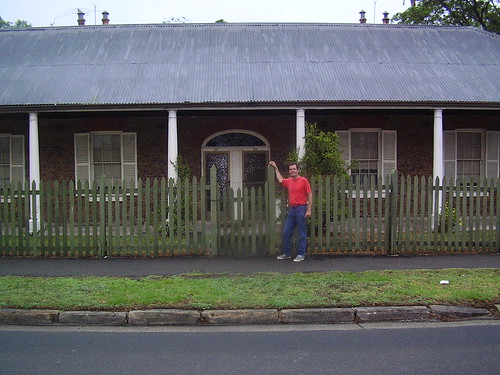 |
| "Roseneath" a heritage-listed house in O'Connell St, Parramatta. Pip Wilson |
.jpg) |
| The King's School, Parramatta, founded in 1831 |
 |
| Parramatta Gaol Constructed between 1835-1842 |
| Lennox Bridge Parramatta carries Church Street over the Parramatta River |
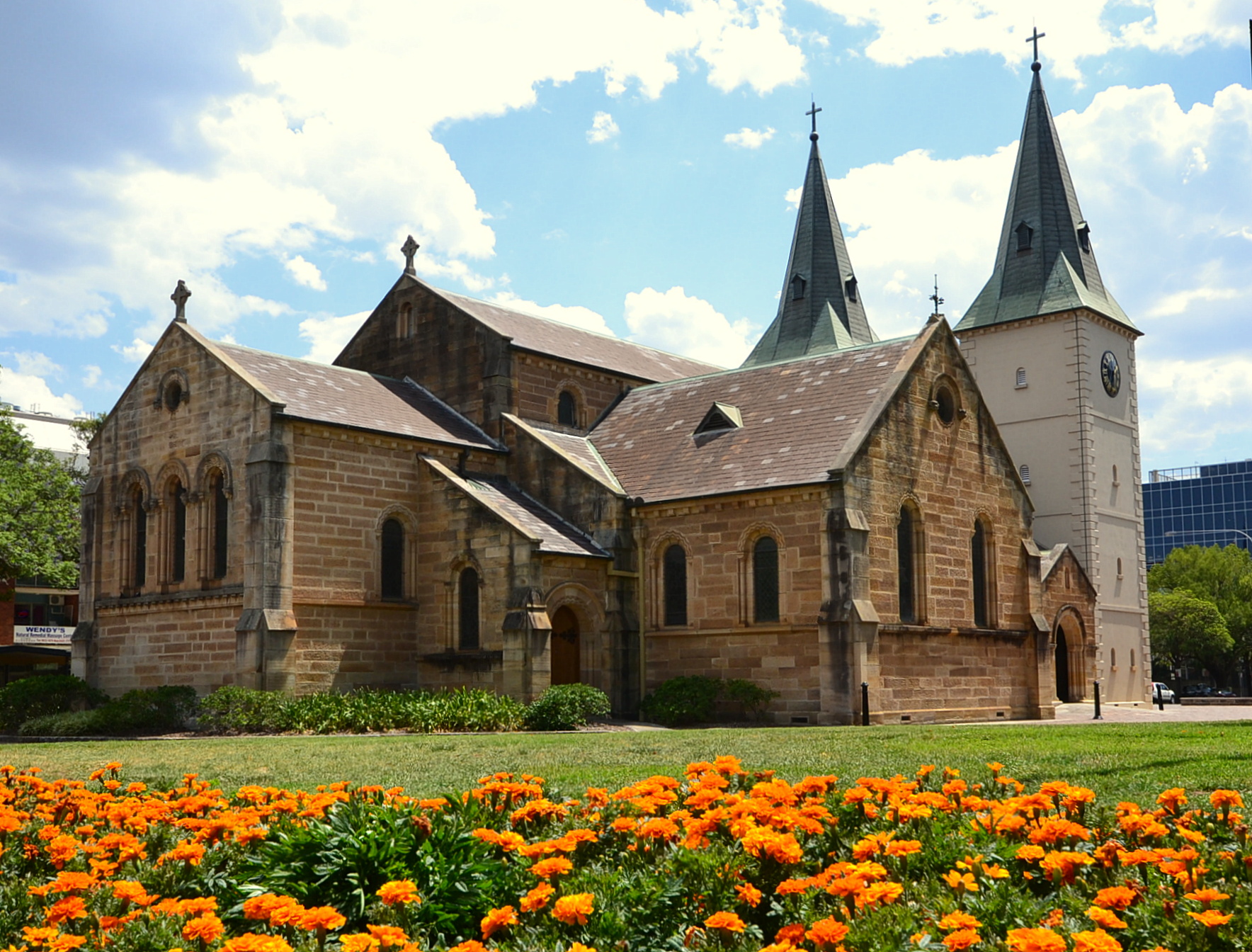 |
| Another view of St. John's Anglican Church, Parramatta |
 |
| Tudor-style gatehouse at Parramatta Park, circa 1884 |
.jpg) |
| The Macquarie Street Gatehouse, Parramatta Park, dates back to 1848. High Gothic style |
Dairy_Cottage-4.jpg) |
| Dairy Cottage, Parramatta park, built 1798 |
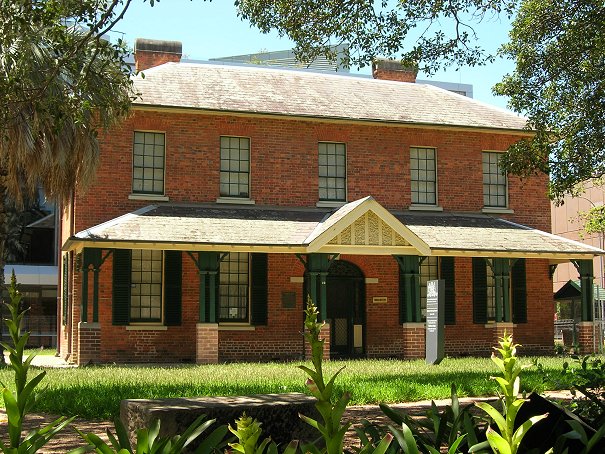 |
| This old Colonial Georgian building was built in 1821 by former convict John Hodges |
 |
| The Parramatta Female Precinct. This two storey building was commissioned by Governor King and the convict women moved in in 1804 |
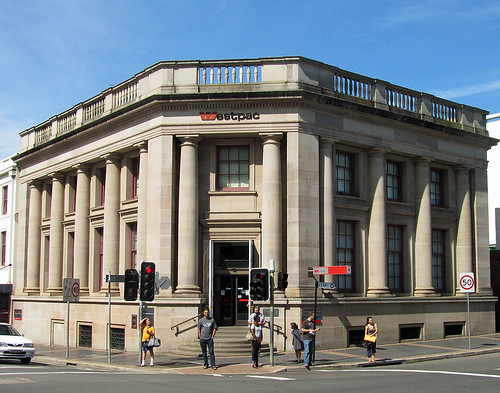 |
| Westpac Bank site in Church Street Parramatta, first taken up by Bank of NSW in 1874 Newtown grafitti |
 |
| Woolpack Hotel, Parramatta, Built c. 1820 with major changes c.1889 |
 |
| Remains of the the 1820s, Parramatta Observatory in Parramatta Park, NSW |
 |
| Perth House and Stables 85 George St Parramatta, circa 1850 |
 |
| David Lennox, pioneer bridge-builder, at 39 Campbell Street, Parramatta |
 |
| Avondale is a heritage-listed former residence and now offices at 25 O'Connell Street, Parramatta, circa 1900 |
 |
| Lancer Barracks is a historic military facility and grounds in Parramatta. Building commenced in 1818 and was completed in 1820 |
St_Patricks_Cathedral_Parramatta-1.jpg) |
| St Patricks, Parramatta, began construction 1836 |
| Lennox Bridge Parramatta carries Church Street over the Parramatta River, Completed in 1839 |
.jpg) |
| Murphy House - Parramatta, New South Wales. Built 1904 |
 |
| Saint George's Terraces, circa 1881, at 44 Phillip Street, Parramatta, also set for demolition |
 |
| Willow Grove, in Parramatta, built 1870, a Victorian Italianate two-storey villa |
 |
| Governor Macquarie-era convict stone bridge over Murray Gardens Creek in Parramatta Park, NSW |
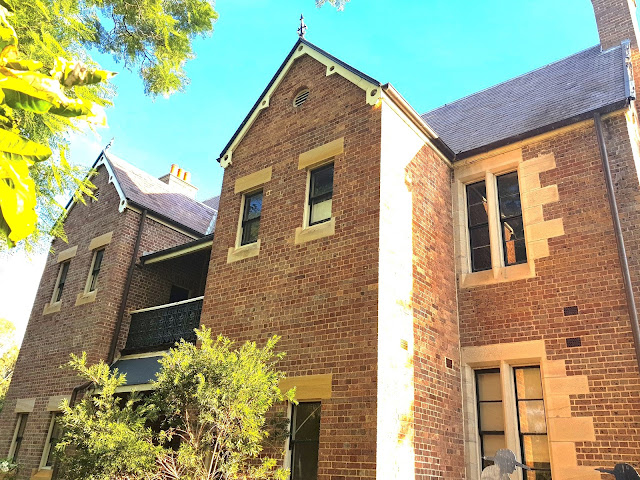 |
| Bethel was built for the Roman Catholic Orphan School, Parramatta, NSW |
 |
| Old Government House Parramatta, NW, built in Georgian style, by Governor Hunter in 1799 |
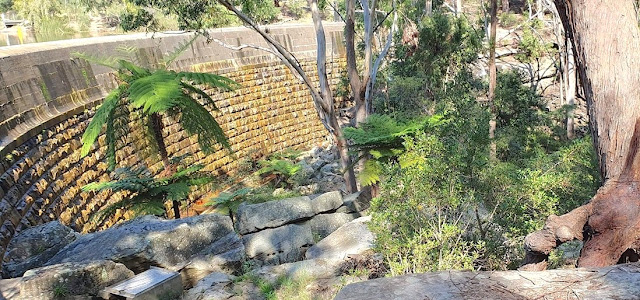 |
| The masonry arch-walled dam across Hunts Creek was completed in 1856 to supply water for domestic purposes, Lake Parramatta, NSW |
Things To Do and Places To Go
A Walk Through Convict Parramatta
Places to Experience Indigenous History and Culture in Parramatta
Free Self-guided History Walk of ParramattaElizabeth Farm |
Sydney Living Museums Brislington Medical and Nursing
MuseumLancer Barracks and MuseumExperiment Farm
Cottage – National TrustHeritage Centre | City of
ParramattaOld Government House ParramattaParramatta
Park | Welcome to Parramatta ParkSt. John's Anglican
CathedralJohn Macarthur's Hambledon Cottage


_-_Google_Art_Project.jpg)










